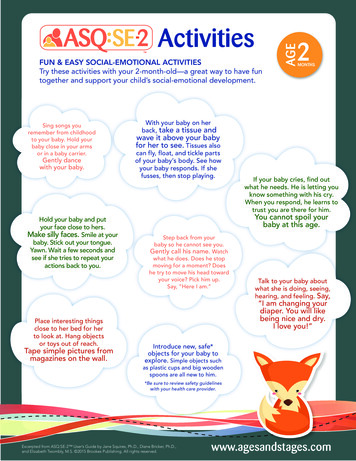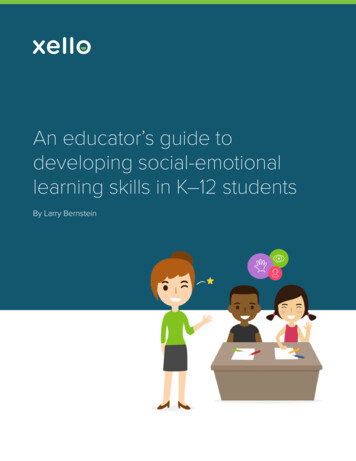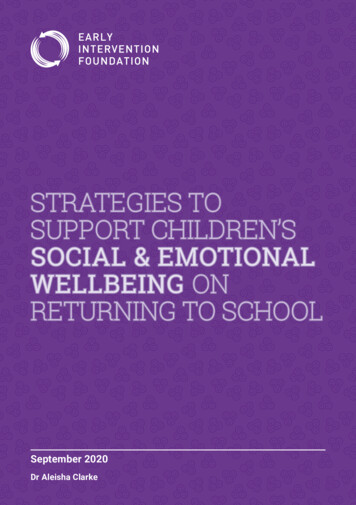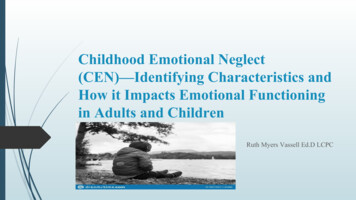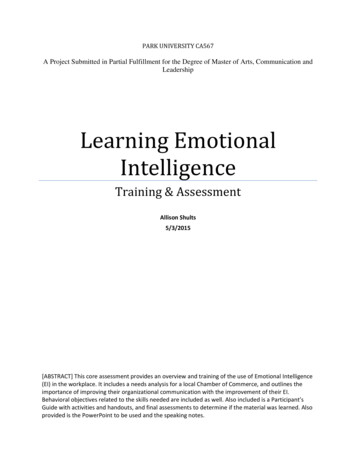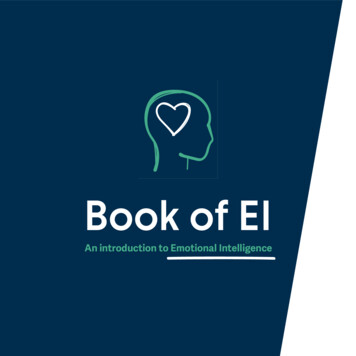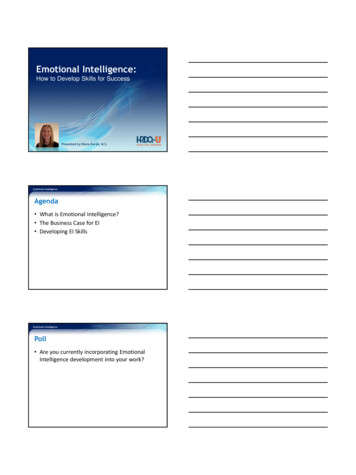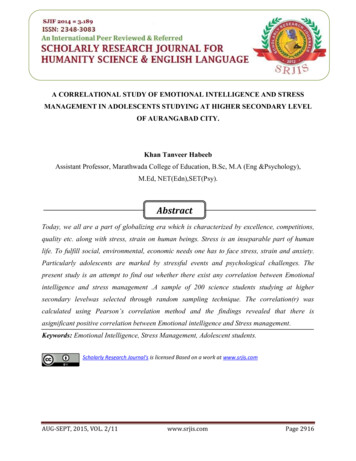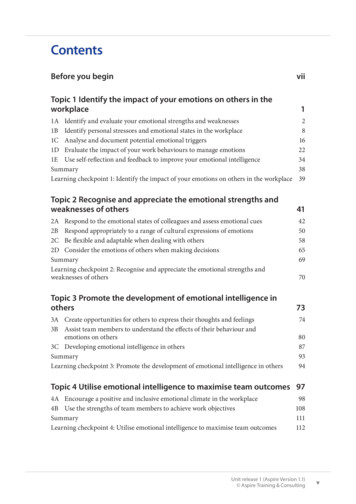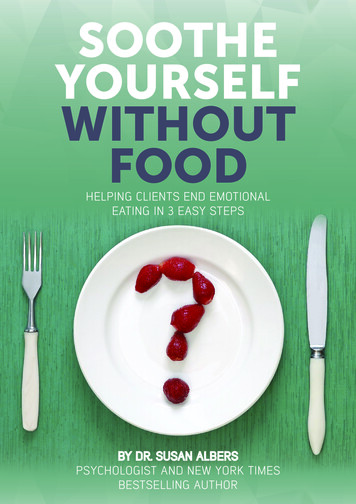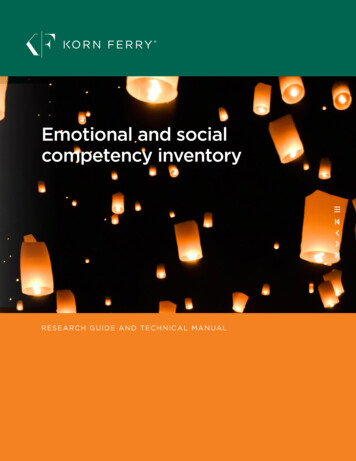
Transcription
Social Emotional Activities Workbook
Section A: Self-Awareness ActivitiesSection ASelf-Awareness Activities
Section A: Self-Awareness ActivitiesInteractive Group Reflection ActivitiesThe following is for facilitators.A Rose and a ThornParticipants are asked to state one “rose,” or good thing that happened for them, and one “thorn,” or challenge that arose. Can be used to at the beginning of a new session to reflect on the last. Can be used as a closing reflection.Standing in the Shadow of Our SuccessThis activity is used to review and reflect on personal and group accomplishments. Individually, participants are asked to considertheir roles in their groups’ success. One by one, participants are asked to physically “stand in the shadow” (the place in the room)where they felt they contributed most in moving the group forward. For example, someone who helped facilitate a large groupdiscussion might go stand by the board. Participants are invited to say 1 or 2 sentences about their contribution.Crossing the LineAll participants are asked to stand on one side of the room. They are told that the facilitatorwill read a series of statements. Once a statement is read, all participants for whom that statement is true personally walk to the otherside of the room. The facilitator might use a reflective prompt such as “Notice who is on one side of the room and notice who is not.”Participants silently acknowledge the configuration of the room’s participants. Participants are asked to rejoin the individuals who didnot move. The exercise is often used to bring the group to awareness of minority viewpoints and/or power dynamics that either exist inthe room or generally influence training.Index CardsParticipants are given two different colored index cards. On one card they are asked to write one thing they’ve learned. On the othercard they are asked to write one question they (still) have. This can be used as a review of the previous session or as a closing for thecurrent session.Circle GameEach participant is given an index card and is asked to write down a question they still have about the session or training. Cards arecollected and placed in a pile. Participants are seated in a circle. One person volunteers to be first to draw a card. The volunteer reads
Section A: Self-Awareness Activitiesaloud the question on the card and answers it. After he or she has given an answer, the question is opened up to others in the group toanswer.Line Up!A facilitator designates a line that represents a continuum that ranges from “strongly agree” to “strongly disagree,” where the middleof the line is “neutral.” The facilitator then reads several reflective statements about the activity the participants just completed. Aftereach statement, the participants place themselves on the line according to their opinion. The facilitator can ask participants to explainwhy they are where they are on the line either to everyone in the group or to one other person next to him/her.Examples of statements after an environmental stewardship activity:Humans can have a positive impact on the environment.Humans can have a negative impact on the environment.I will try to limit my impact on the environmentI have ideas about environmental stewardship activities that I can do at home.Pair and ShareHave participants thoughtfully consider a question or set of questions individually. Then have them find a partner to share theirthoughts. Facilitators can walk amongst groups to supervise.Small Group SharingHave participants thoughtfully consider a question or set of questions individually. Then break into small groups to share and discuss.Facilitators can walk amongst groups to supervise.Mini Teach SessionGroups of participants, after a group activity, or individuals share with the rest of the group something that they learned during theactivity. Other participants are invited to ask questions respectfully.
Section A: Self-Awareness ActivitiesIndividualized ReflectionJournalingVarious journaling techniques can be employed, such as free writing, writing a letter to someone else or to a future or past self, writingin response to a prompt, or writing a poem or creative piece in response to an activity or event. Participants should keep a privatejournal that they can continue to write in throughout the duration of a program.Dialogue JournalParticipants journal in dialogue with an identified staff member. Staff members should respond to and engage with the writing of theparticipant as well as the original prompt or activity.Visual RepresentationParticipants are asked to respond to an activity or a specific prompt by creating a visual representation of their feelings, what they didduring an activity, what change they wish to see in a situation, etc. A variety of visual mediums can be employed, such as paper,colored pencil, crayons, markers, clay, etc. to create a picture, collage, or other visual representation.Gathering Youth Feedback Through ReflectionPluses and DeltasA facilitator asks participants to write down a number of things that they liked about the activity (the “pluses”) and a number of thingsthat they would change about the activity (the “deltas). The facilitator then leads a discussion around first the sharing of things thatwere liked and then the things that could be changed.Line Up!A facilitator designates a line that represents a continuum that ranges from “strongly agree” to “strongly disagree,” where the middleof the line is “neutral.” The facilitator then reads several reflective statements about the activity the participants just completed. Aftereach statement, the participants place themselves on the line according to their opinion. The facilitator can ask participants to explainwhy they are where they are on the line either to everyone in the group or to one other person next to him/her.
Section A: Self-Awareness ActivitiesExamples of feedback generating statements:I enjoyed/had fun during this activity.I learned a lot from participating in this activity.I would participate in this type of activity again.I have a good idea for a different activity that we could do.Pass the BallParticipants stand or sit in a circle. The facilitator asks a question, and a ball or other soft object is passed to a participant who wouldlike to speak. Once that participant is done speaking, s/he passes the ball to another participant, who also answers the question.Examples of questions:What did you like best about this activity?What did you like least about this activity?What did you learn by participating in this activity?What are two or three words you can use to describe how you feel about this activity?What are some other related activities that you would like to do?Why was it important that we worked together to complete this activity?What, if anything, will you do differently at home because of the experiences you hadwhile participating in this service activity?Would you like to participate in this activity again? Why or why not?If we did this activity again, what could we do to make it better?Beach Ball QuestionsBefore the activity, a facilitator writes a reflection question in each section of a beach ball. During the activity, the facilitator asksparticipants to sit or stand in a circle. After 3 “bumps” of the beach ball around the circle, the participant who catches it next willanswer the question that his/her right thumb lands on.
Section A: Self-Awareness ActivitiesI. Self-awareness—accurately assessing one’s feelings, interests, values, and strengths; maintaining a well-groundedsense of self-confidenceActivities: These activities are adapted from The Dove Self Esteem Fund. They are specifically directed towards young women inmiddle and high school.Purpose: They align to the CASEL core competency of accurately assessing one’s feelings, interests, values, and strengths andmaintaining a well-grounded sense of confidence.Format: Personal reflection, discussion, and sharingAge range: Middle and high schoolThe following is a worksheet for youth.GETTING STARTEDAbout me:My name is . I am years old.My school is . I am in grade .About my body:To me being beautifulmeans
Section A: Self-Awareness ActivitiesQuestions I have about my face/hair/chest/bodyareMore about me:My favorite activitiesareWhen I grow up, I want tobeI think the two most interesting things about me are1)2)Questions I have about are growing up are. Check all that apply.o Why am I changing?o Does everyone change the same way?o When is it okay to kiss someone?
Section A: Self-Awareness ActivitiesooooDo I have to diet?It is okay to be excited about growing up?What if I don’t like my legs/breasts/lips?Others?About my friends:My best friend’s name(s) is/areMy best friend/s think/s IamSomething my friends do/say/think that worries meisSomething my friends do/say/think that inspires meisAbout my mom/caregiver:My mom/caregiver’s name isToday I would describe my relationship with my mom/caregiveras
Section A: Self-Awareness ActivitiesOther days I would describe my relationship with mymom/caregiverOne thing I love about my mom/caregiverisActivity Two: To be completed with your mom/caregiver, if possible.You know the basic about your mom/caregiver and (s)he probably knows the basics about you. Let’s delve a little deeper into whoeach of you are. Get out your pen, think like a journalist, and ask these questions to each other to uncover some news. You’ll find outsome insightful facts about one another. You can also ask your grandmother and aunts the same questions.Let’s Share:As a warm-up, find something special that both of you can do. For example: Rise one eyebrowCross your eyesWhistleMom, let me tell you about: My best friendsMy school workHow I feel about my m, tell me about
Section A: Self-Awareness Activities What school was like for youYour best friend from when you were my ageHow you really feel about your family membersLet’s talk about How do deal with bullies and teasingHow I feel about my bodyWhat kissing is likeHow I really feel about getting my periodHow I really feel about getting a braActivity 3: Where I’m FromEvery family is different. It is the particular ingredients of your family that makes your family unique. Families are made up ofdifferent parts with everyone bringing something special to it.Talk About ItHow does where you are from influence who you are? This might include religion, region, ethnicity, how old your parents/caregiversare, what beliefs you share as a family, whether you come from a single or two-family home, whether or not you have siblings . Thelist goes on.Discuss these questions with a caregiver or a friend. Exchange information, if you choose.Where did your grandma grow up?How is your family unique?What makes you unique?
Section A: Self-Awareness ActivitiesHow am I beautiful?What are some things I admire in my family members?What are some things I admire in others?What are some things I admire in myself?What have I learnt about my family that I didn’t previously know?How—if at all—does that change my relationship with my family?Activity 4: My HopesSometimes you need a quiet moment to reflect on all the changes and activities in your life. Use this space to consider who you are, oryou use your journal. Write down your thoughts about what you’ve learned so far about yourself and your mother.Think About It!What makes meunique?Who are my rolemodels?
Section A: Self-Awareness ActivitiesWhy?Who are my bestfriends?Why?What do I want tobe?What skills do I want todevelop?Take a moment to look at the things that make you, you. Write down one goal for yourself for this semester or this year or this month(or even just today!) Try to make it as specific as possible. Come up with a plan to achieve that goal.One thing I would like to explore further or achieveisTo do this Icould
Section A: Self-Awareness ActivitiesOne step I can take nowisSubsequent steps mightbe
Section A: Self-Awareness ActivitiesI.Self-awareness—accurately assessing one’s feelings, interests, values, and strengths; maintaining a well-groundedsense of self-confidenceActivities: Instructions for facilitators in leading group activities designed to explore and build a well-grounded self-confidencePurpose: To help youth explore and develop a well-grounded sense of self-confidenceFormat: Hands-on, interactiveAge range: Middle school and high school, grades 6-12The following is for facilitators.Advertising Yourself: In this activity, one has to persuade the audience to become his friend. In the process, the person tries to findhis qualities and also lets the others know about them. He can make use of words and pictures for persuading the people. Here, theparticipant is thinking about advertising himself as a friend, so it is natural for him to think positively. If he gets stuck in between, theaudience can participate in this activity in order to encourage him. This interaction acts as a boost to build his self-esteem.Gauntlet: A gauntlet is a kind of a glove which is a part of a medieval armor. In this activity, two rows are formed with people facingeach other. Since the passage between these rows is like a tube, the game is known as gauntlet. Every participant is made to walkthrough these rows. As he proceeds, the members of the row pat him on the back, hug or say kind words to him. The participant isadvised to walk slowly so as to pay attention to every gesture. This activity - the gauntlet, reminds us of a cricket game wheresportsmen passing through the spectators are cheered and patted on their backs.Discussion: This activity is conducted in a group. Every person in the group is given a theme on which he needs to write about, afterwhich he participates in a discussion on the theme.Interview: An interview greatly helps in overcoming low self-esteem. In this activity, members of a group choose a theme and writeon it. The person is then interviewed by other members of the group. Here, the person learns to present the topic systematically, whichin turn, increases his confidence.
Section B: Self-Management ActivitiesSection BSelf-Management ActivitiesA. Pet Peeves!
Section B: Self-Management ActivitiesName:Partner’s name:1. What's the most annoying catchphrase or cliché you can think of?2. What is something that your parents do (or a friend does) that annoys you?3. Does it annoy you when people kiss in public? Why?4. What annoys you about taking trains? (or a bus, tram, plane)5. What annoys you about driving a car?6. Does it annoy you when people snore?7. What annoys you about yourself?Critical thinking: When someone does something that bothers (annoys) you; do you address them right away? Or, do you ignore thebehavior? Explain why or why not.
Section B: Self-Management ActivitiesThe following activity can be facilitated by a staff member.C. Recognizing Emotions
Section B: Self-Management ened/shocked
Section B: Self-Management ActivitiesconfusedTiredscaredin loveExcitedFine/GoodMoods and FeelingsSickCrazy/goofyUpset
Section B: Self-Management ActivitiesII.Self-management—regulating one’s emotions to handle stress, control impulses, and persevere in overcomingobstacles; setting and monitoring progress toward personal and academic goals; expressing emotions appropriatelyActivities: The following lessons and skills have been adapted from a “mindfulness” curriculum based on the principles of DBT,Dialectical Behavioral Therapy.Purpose: These lessons and skills are aligned to the CASEL core competency of regulating one’s emotions to handle stress andexpressing emotions appropriately. A core tenant of DBT is the practice of “mindfulness”-the calm acceptance of one’s thoughts asthoughts, as opposed to statements of fact that have the power to harm. Mindfulness assumes that the participant has the ability toobserve his or her thoughts.Format: Discussion and reflection; independent or group questions and activitiesAge range: The following lesson is intended for high school but, with modifications, could be appropriate for middle school.The following can be discussed and facilitated by a facilitator.CORE MINDFULLNESS SKILLS
Section B: Self-Management ActivitiesOBSERVE Be curious about what you feel.Just notice how you feel, without trying to make feelings stronger, weaker, disappear, or last longer.See how long your feelings last, and if it changes.Notice how feelings flow in and out of your body like waves.What comes through your sense? Touch, smell, sight, sound, taste.Be like a non-stick pan, letting things slide off your body and your emotions.DESCRIBE Use words to describe your experience.Use “fact” words, call a thought “just a thought” and call a feeling “just a feeling.”Use words that everyone would agree with.Don’t paint a colorful picture with words, or magnify a situation with words.Try to avoid emotional words.Try to let go of your emotions about being “right” or about someone else being “wrong” while searching for words to describeyour feelings.PARTICIPATE Get “lost” in an activity.Let go of your sense of time while participating in the activity.Be present in the situation, rather than thinking about other things you could or should be doing.Practice your skills until they become a part of you.All content adapted from Dialectical Behavior Therapy Skills Handbook. Fulton State Hospital, 2004CORE MINDFULNESS-HOW TO INCORPORATE THE SKILLSPractice to Use These All at the Same TimeNON-JUDGMENTAL STANCE
Section B: Self-Management Activities SEE, BUT DON’T EVALUATE. Take a non-judgmental stance. Just the facts. Focus onthe “what,” not the “good” or “bad.”UNGLUE YOUR OPINIONS from the facts.ACCEPT each moment non-judgmentally, as a tree accepts both the sun and rain thatfalls upon its branches.ACKNOWLEDGE the helpful, but don’t judge it. Acknowledge the harmful, but don’tjudge it.When you judge, DON’T JUDGE YOURSELF FOR JUDGING.MINDFULLY IN THE MOMENT DO ONE THING AT A TIME. When you are eating, eat. When you are walking, walk.When you are working, work. When you are in a conversation with a friend, be present inthat conversation with your friend. Give each activity your whole focus.If other actions, thoughts, or strong feelings distract you, LET GO OF DISTRACTIONS,and go back to what you are doing—go back again and again and again.CONCENTRATE YOUR MIND. If you find you are doing two things at once, stop andgo back to one thing at a time.EFFECTIVELY
Section B: Self-Management Activities FOCUS ON WHAT WORKS. Do what needs to be done in each situation in order tomeet your goals. Stay away from evaluative language: “I am stupid because I didn’t getan A” or “My teacher ignores me because she hates me.”INSTEAD, FOCUS ON THE FACTS. “I didn’t get an A because geometry is very hardfor me. I will study harder next time” or “My teacher hasn’t been calling on me lately. Iwill tell her that this frustrates me.”LET GO of vengeance, useless anger, and self righteousness that hurts you and doesn’twork in the long run.All content adapted from Dialectical Behavior Therapy Skills Handbook. Fulton State Hospital, 2004OBSERVING AND DESCRIBING THOUGHTSDescribe a situation in which you felt out of control emotionally. How did you feel? What were the circumstances? Did you useevaluative language to judge yourself or another person during the situation? What thoughts did you have during the situation?How did you react physically to the situation? Did you yell, hit things, cry? What do you think prompted that physical response?Can you revisit that situation from a non-judgmental stance? In other words, if you were going to describe what happened using onlythe facts and removing all evaluative and emotional language, what would you say?
Section B: Self-Management ActivitiesWhat is the effect of removing all evaluative language from an emotional situation?All content adapted from Dialectical Behavior Therapy Skills Handbook. Fulton State Hospital, 2004EXPRESSING EMOTIONS EFFECTIVELYPractice observing and describing your emotions about the followings situations that you might experience. Remember to focus on thefacts and avoid evaluative language. Focus on how the situation makes you feel and how you could best express how you feel.1) You feel ignored by a favorite teacher. She always seems to have time for other students.2) Your best friend was supposed to meet your for dinner. He is an hour late.3) You come home late from the library. Even though you tell your mom where you’ve been, she grounds you for a week.4) Your own example—any time when you needed to express your emotions to another person.
Section B: Self-Management ActivitiesAll content adapted from Dialectical Behavior Therapy Skills Handbook. Fulton State Hospital, 2004Extra Skills for Solving Conflicts With OthersThe following are some helpful tips for solving conflict with other people, including friends, caregivers, and teachers.The goal of these skills is not to win an argument, but to figure out how to discuss conflict in an appropriate way so, in thefuture, the situation can look different.1) Describe: Clearly state what the problem is.a. Phrase the problem in terms of behaviors that are currently occurring or not occurring.b. Break large problems into smaller, concrete problems and deal with them one at a time.c. Make certain that the other person is ready to discuss the problem.2) Express: Clarify why the issue is important to you.a. Clarify why the issue is important to you and provide your understanding of the issues involved.b. Explain what your desires are, but do not offer solutions.3) Assert: Discuss possible interviews.a. Stay solution-oriented; your goal is not to defend yourself, decide who is right or wrong, or establish the truth regardingwhat happened in the past.b. Your goal is to decide how to do things differently in the future.c. If you tend to get focused on a single or limited number of alternatives, consider brainstorming (creating a list of manydifferent kinds of solutions to the conflict).4) Negotiate: Decide on a solution that is agreeable to both of you.a. If you cannot find a solution which greatly pleases both partners, suggest a compromise solution.b. State your solution in clear and specific terms.c. After agreeing on a solution, have your partner restate the solution.d. Do not accept a solution which you do not intend to follow through.e. Do not accept a solution which you believe will make you angry or resentful.5) Decide on a trial period to implement the solutiona. Allow for several attempts of the new solution.b. Review the solution at the end of the trial period.
Section B: Self-Management Activities
Section B: Self-Management ActivitiesSection CSocial Awareness Activities
Section B: Self-Management ActivitiesIII. Social awareness—being able to take the perspective of and empathize with others; recognizing and appreciatingindividual and group similarities and differences; recognizing and using family, school, and community resourcesActivity: Instructions for facilitators to conduct hands-on diversity activity, discussion, and reflectionPurpose: The goal of this lesson is for students to recognize the similarities and differences between one another and to develop aworking definition of diversity.1This activity is aligned to the CASEL emotional core competency of establishing and maintaininghealthy rewarding relationships based on cooperation. Note: This lesson is particularly useful in the beginning of the school year tohelp students become acquainted with students they may not know.2Format: Hands-on portion is individual; discussion and reflection can be whole group or small groupAge range: Middle and high schoolMaterials: Blank, five-pointed stars with space in the middle for students to write their names or draw/paste a picture; markers; chartpaperThe following are instructions for staff in facilitating activities.1) Give each student a star to personalize. Have students either write their names and/or paste/draw a picture of themselves in themiddle of the star.2) Tell students that each point of the star represents a category. Tell students to write their answers for each category at thepoints of their star. Note: The categories should be the same for all students and should be decided upon in advance ofthe activity. They should be on a sheet of paper handed out to each student or written on the board. Suggestedcategories include: state or country where I was born, a hobby I enjoy, my strongest quality, my favorite school subject,my least favorite school subject, my intended career, my favorite sport, and so on 3) After students have completed their stars, have them move around the room and find as many matches as they can with otherstudents. Have students make a list of all the classmates with whom they have something in common.4) List the five categories on a piece of chart paper and elicit students’ responses for each category. (Students could also bedivided into groups and answer the following questions amongst themselves.) The questions could include:1For more information about diversity curriculums for middle school students and high school students see Building Community and Combating Hate: Lessonsfor the Middle School Classroom. A publication of Partners Against Hate2Adapted from Opening the Door to Diversity: Voices From the Middle School (Resource Guide). 1999.Westerville, OH: National Middle School Association.
Section B: Self-Management Activities5)6)7)8)A) Are you surprised at the number of similarities that exist among the people in this class? Why or why not?B) How is recognizing these similarities important to how we work together?C) Could any of these similarities cause problems?D) What kinds of differences exist among people in this class?E) How is recognizing these differences important to how we work together?F) Could any of these differences cause problems? Explain your thinking.G) Why is it important to recognize the differences and similarities that exist among people?Ask students to think about the meaning of the word diversity. Either as a whole group or in small cooperative groups, havestudents prepare a ‘web’ using the word “diversity.” Have them include both their own general understanding of the word andas many examples as possible (for example, different races, religion, languages, family structure, etc )Have the students work together to develop a working definition of diversity that takes into account all of their thinking. Writethe class’s definition on a piece of chart paper.End the lesson by asking students to reflect on why they think you have asked them to participate in this assignment and howhaving a class definition of diversity may be useful.Post student stars, the compilation of student responses, and the class definition of diversity I the classroom.III.Social awareness—being able to take the perspective of and empathize with others; recognizing and appreciatingindividual and group similarities and differences; recognizing and using family, school, and community resourcesActivity: Instructions for facilitators to conduct hands-on activity, reflection, and discussion on diversity and societyPurpose: To prompt reflection and discussion on youth opinions on social issuesFormat: Hands-on activity, reflection, and discussionAge range: Middle and high school
Section B: Self-Management ActivitiesMaterials: Three large pieces of construction paper with the following words written in very large letters, one on each sheet of paper:“Agree,” “Disagree,” and “Unsure.”Process1) At one end of the room post (or have students post) a large sign labeled “Agree” and at the other end post a large sign labeled“Disagree.” In the center of the room post a sign labeled “Unsure.”2) Explain to the students that you are going to read several statements, none of which have a “right” or “wrong” answer. As eachstatement is read, tell them they are to take a position in the room based on whether they agree, disagree, or are unsure aboutthe accuracy of the statement.3) Read some or all of the following statements and allow time for students to take a position following each one. Ask them toobserve how people change positions from one topic to the next.A) Students should be required to recite the Pledge of Allegiance in school.B) Public schools should require all students to wear uniformsC) Parents should carefully monitor how their children use the internet.D) Video games make teens violent.E) Prejudiced people cannot be changed.F) Most young people do not respect adults.G) Most adults do not respect teenagers.H) Rap music makes teens violent.I) Rap music glamorizes drug use.J) Jokes that focus on race, ethnicity, or sexual orientation reinforce prejudice.K) The media unfairly portrays certain groups of people.L) There is too much focus on diversity and multiculturalism in the school curriculum.M) If the United States government sends you to prison, you definitely deserve to be there.N) Terrorists are evil.O) Anyone who wants to come to the United States should be allowed to enterP) Since the World Trade Center and the Pentagon attacks, the world is no longer safe.Q) Bullying is a normal part of life at school.R) School violence is a major problem in this country.4) Ask students to make general observations about the lesson and to explain how they felt sharing their opinions on some of thetopics. Guide a whole-group discuss using the following questions. (Or have students self-divide into small groups and ask astudent leader to ask the following questions):A) How did it feel to take a position on some of the topics?
Section B: Self-Management ActivitiesB) If there was a particu
Section A: Self-Awareness Activities I. Self-awareness —accurately assessing one's feelings, interests, values, and strengths; maintaining a well-grounded sense of self-confidence Activities: These activities are adapted from The Dove Self Esteem Fund . They are specifically directed towards young women in
